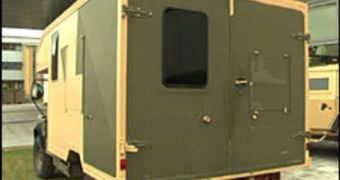Scientists in the United kingdom are working on creating a new type of paint that could be applied as a coating of the normal stuff, but would have the ability to render chemical attacks useless. The research work associated with producing the new asset is being done at the UK Defense Science and Technology Laboratory (DSTL), the BBC News reports.
The new paint is made in the form of strips, similar to the coatings that the military currently uses to apply temporary camouflage to its vehicles. The main goal of this innovative technology is to allow vehicles to essentially soak up dangerous chemicals from the air in the event of a chemical attack, making the environment around the APC or transporter safe for its occupants. In the future, DSTL experts say, it may become possible to outfit the new paint coatings with enzymes and catalysts that would allow them to interact with the chemical they soak up, and thus decontaminate themselves.
“Ultimately, what we'd like to create is a coating that changes color to indicate it's been contaminated, decontaminates itself, then returns to the original color when it's clean. This is a long-term but not unreasonable ultimate objective,” the DSTL acting team leader for hazard management and decontamination, Dr. Steven Mitchell, from the lab's headquarters, in Porton Down, Wiltshire, told the British news agency. He added that the new paint could also be engineered in a way that would diminish a vehicle's glint, or the amount of sunlight it reflected. This can often reveal a machine to the enemy.
“There are a number of advantages to this technology. One is its flexibility; it is easy to apply and easy to remove. You can change your colour or your signature in theater in a relatively straightforward manner. It's a single pack emulsion. It looks much like paint you'd find in a DIY store for painting your house. So you could apply it with a paint brush, or you could apply it with a roller. It's really flexible. That's important for potential use in theater because you might not have a sophisticated paint spray system available,” the expert said of the new paint.
The chemical-absorbing coating could be applied in a large number of areas around vehicles such as ambulances, but liquid decontamination would still be required for parts such as tracks, engines, suspension, and other places that cannot be coated. But the main idea is to make the larger areas of the vehicle able to absorb chemicals, so as to protect people from getting contaminated and spreading the infection. Dr. Mitchell explains that the probability of a soldier leaning on the side of a vehicle is much higher than the chance of him or her putting their hands on the tracks or wheels.
“Maybe we'd also like to put some chemistry into the coating that would then react with and decontaminate the agent itself. And then perhaps even a color change to tell you that process has been successful and the agent has been destroyed. Clearly, there are a lot of technical hurdles to be overcome to develop something this sophisticated,” the DSTL expert concluded.

 14 DAY TRIAL //
14 DAY TRIAL //